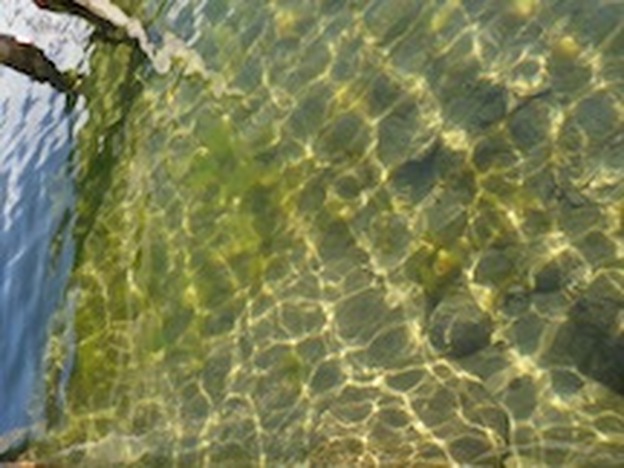Septic Issues on Assembly Point
 Septic leakage is one cause of nutrient loading around the southern basin of the lake. Algal blooms, green rocks and scum on docks, dock ladders and boats are one indication of possible septic leakage.
This picture shows early April algal blooms discovered by Bob Tully off east side Assembly Point.
Septic leakage is one cause of nutrient loading around the southern basin of the lake. Algal blooms, green rocks and scum on docks, dock ladders and boats are one indication of possible septic leakage.
This picture shows early April algal blooms discovered by Bob Tully off east side Assembly Point.
Septic issues:
The Assembly Point Water Quality Coalition began looking at Town septic records in winter 2014 in an effort to gather information about septic system age, condition and pump outs. To help update the town's records, a questionnaire was sent out to residents, requesting information abut location, size and pump outs. The response to the request was weak. Many residents were not knowledgeable about their septic systems, and were not able to answer the questions.
In the fall of 2018, the town of Queensbury passed the Septic Transfer Law, which is posted below. This was a critical first step toward monitoring septic systems, requiring the seller to inspect his septic system prior to finalizing the sale of his property, ensuring that the onsite septic system is functning properly. The law has proven to be a success, ensuring the repair and /or replacement of numerous faulty systems.
In 2020, a subset of the APWQC, along with representatives from other waterfront towns, formed a septic group to promote a lakewide Septic Inspection Program. The group wrote a letter to Governor Cuomo, requesting that the Lake George Park Commission adopt this initiative. The time seemed right, as multiple government officials, environmental groups and members of the press verbally supported this initiative. The septic group authored a Resolution in March 2021, requesting that the Lake George Park Commission develop an inspection program, and presented this Resolution to each of the 9 lakefront town boards for their vote of support (click button below to access Resolution). Our own town supervisor, John Strough, voiced strong support for a Septic Inspection Program in a stirring editorial, "Old septic systems a threat to lake," printed in the Times Union, 5/1/21. Click on button below to access editorial.
|
Determination of algae species along the shorelines can provide information indicating the source of pollution including septic and stormwater runoff. Bacterial coliform counts can indicate septic leachate reaching the lake. The Palmer Pollution Index is the test which can determine algae by genus. Testing takes place locally through the Fund for Lake George. The APWQC recently received a grant for a snorkel swim and collection of algae around Assembly Point in summer of 2018 with testing using the PPI (Palmer Pollution Index) to determine whether organic pollution may be indicated in the water. Email [email protected] if you wish to know what has been seen off your shoreline. Below are algal photos from 2014-17 taken by a professional diver swimming with APWQC residents. This is what the bottom of the lake around Assembly Point increasingly looks like due to septic, fertilizer and stormwater runoff. |
.
The Clarus Fusion is an enhanced treatment unit designed for areas that have high water tables in strong rain events and inadequate land for leach fields or treatment. The Dunham's Bay Waste Water District has installed a number of these since 2014 to mitigate septic leakage into the lake.
Brochures describing a Clarus Fusion enhanced treatment unit (ETU) and septic conditions in the Assembly Point area are available below for download. The recently passed Town of Queensbury Septic Transfer Law is also posted below
The Clarus Fusion is an enhanced treatment unit designed for areas that have high water tables in strong rain events and inadequate land for leach fields or treatment. The Dunham's Bay Waste Water District has installed a number of these since 2014 to mitigate septic leakage into the lake.
Brochures describing a Clarus Fusion enhanced treatment unit (ETU) and septic conditions in the Assembly Point area are available below for download. The recently passed Town of Queensbury Septic Transfer Law is also posted below
| clarus_fusion_brochure.pdf | |
| File Size: | 5130 kb |
| File Type: | |
| rev.7septic_brochure.pdf | |
| File Size: | 3354 kb |
| File Type: | |
UPDATE December 2020
The Septic Inspection upon Property Transfer Law was passed in summer of 2019 after several public hearings, under the leadership of town supervisor John Strough. Since its inception in the fall of 2018, numerous septic inspections at the time of sale in Queensbury (and later Bolton, where a similar law was passed) have overwhelmingly shown the impact of this mandate.
| septic-inspection-upon-property-transfer-october-15-2018.pdf | |
| File Size: | 173 kb |
| File Type: | |











